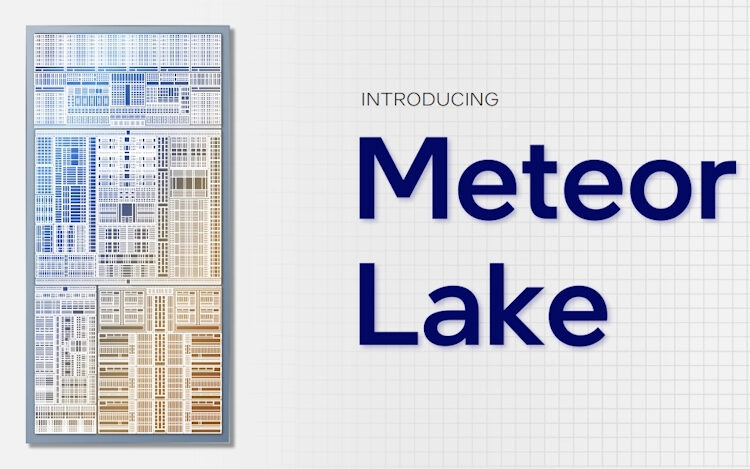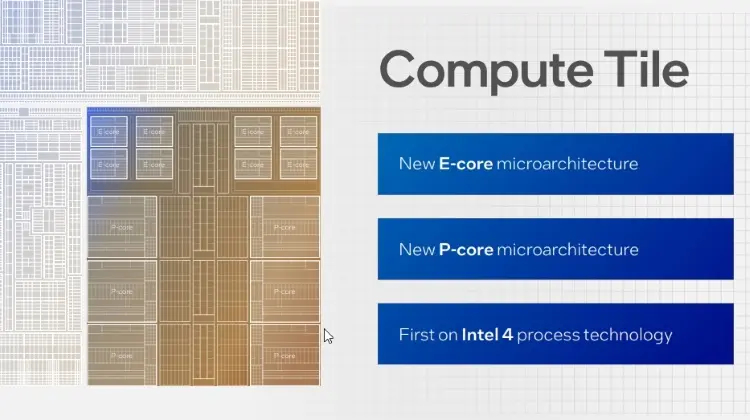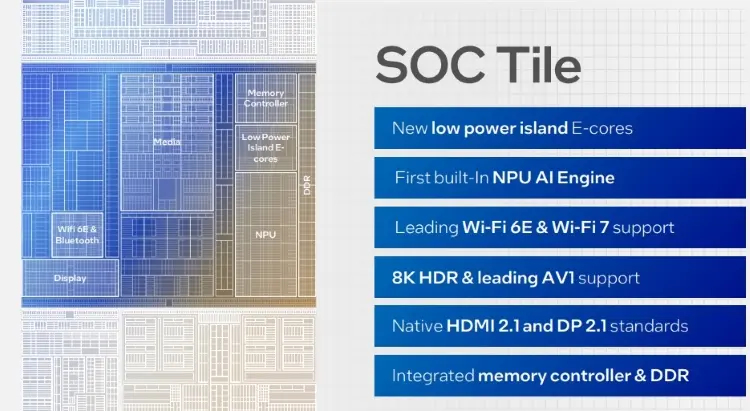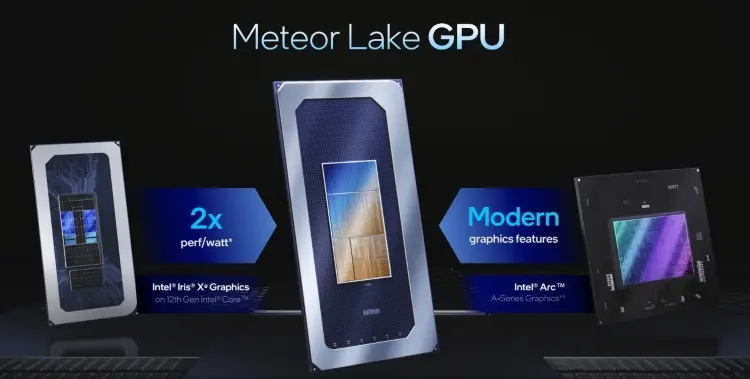
Intel has officially unveiled the 14th-generation Meteor Lake architecture during its highly anticipated Innovation 2023 event. According to Intel, this new architecture promises to transform the computing landscape by introducing on-device AI capabilities and delivering power-efficient performance. Built on Intel 4 process technology, the architecture also introduces integrated Arc-based GPU to mobile processors. For further insights into Intel’s forthcoming 14th-Gen mobile processor, all pertinent details are outlined below.
Meteor Lake Built on Intel 4 Process Technology
Intel’s 14th-gen Meteor Lake mobile processors signify a significant paradigm shift in the company’s trajectory. Representing Intel’s most substantial architectural overhaul in 40 years, the Meteor Lake processors are constructed on Intel 4 process technology. This advancement heralds unprecedented power efficiency in Intel chips, setting a new standard for the industry.

In 2021, Intel discontinued the use of “nm” as a process node descriptor and introduced new naming conventions, aligning with industry standards set by foundries like TSMC and Samsung. Intel 4, formerly referred to as Intel 7nm, is one such example. It boasts a transistor density comparable to TSMC’s 5/4nm and significantly surpasses Samsung’s 4nm process node. This renaming aims to accurately reflect the competitive parity among third-party foundries.
Despite being fabricated on the 7nm process, Intel 4 process node offers a notable 20% improvement in performance per watt compared to the previous Intel 7 process. Notably, Intel 4 process technology fully embraces EUV lithography, enhancing efficiency and performance per watt. Consequently, Meteor Lake chips are poised to be the most power-efficient processors ever produced by Intel. It’s essential to note that the Intel 4 process node is exclusively utilized in the Compute tile, which encompasses CPU cores, including both P and E cores.
Intel’s Meteor Lake Has Four Distinct Tiles

Intel dubs Meteor Lake as its most significant architectural transformation because it has successfully interconnected four disaggregated tiles to form a system-on-chip. This integration encompasses four independent tiles: Compute, SoC, GPU, and IO, embedded within the 14th-Gen mobile chips. Leveraging Intel’s cutting-edge Foveros 3D packaging technology, these tiles function as a cohesive unit, akin to a monolithic SoC housed within a single die. Now, let’s delve into the functionalities of each individual tile.
Compute Tile Introducing New P-Cores and E-Cores

For the Compute tile within its 14th-Gen Meteor Lake processors, Intel has introduced a novel E-core (Crestmont) and P-core (Redwood Cove) microarchitecture. Fabricated on Intel 4 process technology, these cores deliver impressive power efficiency and performance.
Moreover, Intel has segmented compute-intensive IP cores and affixed them autonomously to the SoC fabric. This arrangement allows these IP blocks to access memory independently, thus preventing the core complex from remaining occupied. Consequently, it enhances the chip’s power management optimization.
SoC Tile Featuring Low Power E-Cores
The SoC tile plays a central role in the 14th-Gen Meteor Lake processors, representing a significant advancement in hybrid computing, a concept initially introduced with the 12th-Gen Alder Lake processors. This tile is newly constructed on a 3D performance hybrid architecture. It incorporates low-power island E-cores tailored for handling a wide array of low-powered workloads on laptops.

For instance, during media playback, the low-power island E-cores can activate to deliver performance without engaging the P or E core in Compute. This strategy significantly conserves battery life and enhances power efficiency.
Additionally, the SoC tile boasts an integrated NPU (Neural Processing Unit) for on-device AI capabilities, which will be discussed in detail below. Furthermore, it provides onboard support for Wi-Fi 6E, Wi-Fi 7, and Bluetooth. Notably, Intel has introduced AV1 support with the Meteor Lake processors as part of the Media engine, enabling the rendering of 8K HDR videos. Moreover, the SoC tile incorporates support for native HDMI 2.1 and DisplayPort 2.1 standards, along with an integrated memory controller.
New Intel Arc-based GPU Tile
To deliver discrete-level performance on laptops, Intel has made a significant investment by integrating an Arc-based GPU into the 14th-gen Meteor Lake processors. The A-series graphics from Intel have garnered positive feedback, and the addition of an integrated GPU based on the Arc architecture to its latest mobile processors further enhances their appeal.
Compared to the Intel Iris X graphics found in 12th-gen Intel processors, the new Meteor Lake GPU achieves an impressive 2x performance per watt improvement. This advancement is truly remarkable, isn’t it?

To enhance the power efficiency of the GPU tile, Intel has implemented several architectural changes. Notably, the Media IP core has been separated from the GPU, with both components independently connected to the core complex and memory. This modification significantly reduces unnecessary traffic and improves power efficiency.
For instance, in previous architectures, the core complex remained active during media playback because of memory access through the Ring fabric. However, with the redesigned architecture in Meteor Lake, all IP blocks have independent pathways to memory. Consequently, the GPU and core complex can remain idle, leading to enhanced battery life.
IO Tile With PCIe Gen 5 and Thunderbolt 4

The Intel 14th-gen Meteor Lake processors are equipped with a dedicated IO tile to offer top-notch input/output options for laptops. This tile supports the latest connectivity standards such as Thunderbolt 4 and PCIe Gen5. As a result, users can anticipate unparalleled speed when utilizing next-generation SSDs and external GPUs on laptops powered by Meteor Lake.
On the Intel 14th-Gen Meteor Lake Chips: Integrated NPU
It’s no secret that Apple’s M-series chips boast a dedicated Neural Engine, making M-series MacBooks a popular choice among developers and users alike for running on-device AI models. Recently, these machines have garnered widespread favor due to their capability in this regard. Having utilized local AI models on my Intel-powered desktop machine, I can attest to the less-than-optimal experience, as it lacks a dedicated AI engine.

With the upcoming Meteor Lake processor, Intel is poised to bring AI capabilities to laptops on a large scale. In a groundbreaking move, the 14th-gen Meteor Lake processor incorporates a built-in NPU (Neural Processing Unit) within the SoC tile, marking Intel’s debut integration of an NPU directly into the processor. This integration is expected to significantly outperform the CPU or GPU for sustained AI workloads. Previously, inference latency was a challenge on older Intel processors, but this is set to change with Meteor Lake.
Moreover, the AI engine is compatible with frameworks like OpenVINO for optimizing deep learning models. Additionally, Intel has incorporated AI computing engines into both the CPU and GPU. While the CPU is well-suited for low-latency AI tasks, the GPU excels in delivering high throughput for 3D applications, rendering, and media-related tasks.



